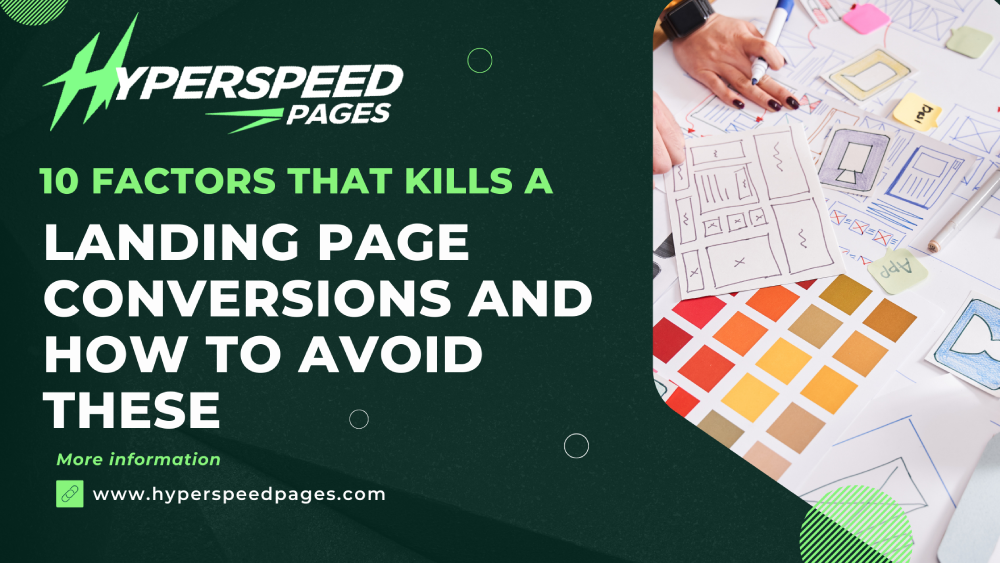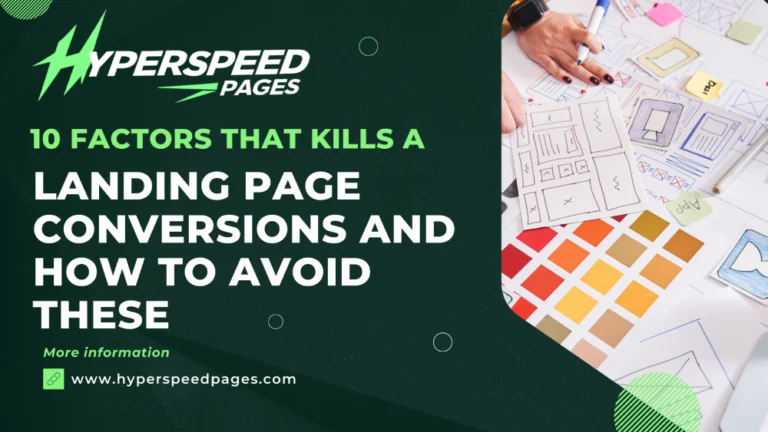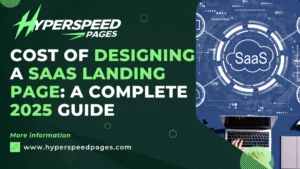
Landing pages are crucial for converting visitors into leads or customers. However, despite the best intentions, many landing pages fail to deliver the desired results. The reasons for this are often rooted in common mistakes that can undermine the effectiveness of a landing page. Let’s identify the various factors that can kill a landing page’s performance and provide actionable insights on how to avoid these pitfalls. In the end, you can create landing pages that are optimized for conversions, user experience, and search engine rankings.
The Landing Page Killers
Cluttered and Confusing Design
A cluttered design is one of the quickest ways to kill a landing page. When visitors arrive on a page that is visually overwhelming, they can become confused and disoriented, leading to high bounce rates.
How to Avoid
- Prioritize Simplicity: Focus on a clean, minimalist design that highlights the most important elements, such as your value proposition and call-to-action (CTA).
- Use White Space Effectively: White space isn’t just empty space; it’s a design tool that can help guide the user’s eye and create a more breathable layout.
- Consistent Visual Hierarchy: Establish a clear visual hierarchy by using different font sizes, colors, and spacing to emphasize key information. Headlines should stand out, followed by subheadings, and then body text.
- Avoid Unnecessary Elements: Remove any elements that don’t serve a specific purpose. This includes excessive images, text, or features that could distract from the main message.
2. Lack of a Clear Call-to-Action (CTA)
The call-to-action (CTA) is the driving force behind any landing page. Without a clear and compelling CTA, visitors may not know what action to take, resulting in missed conversion opportunities.
How to Avoid
- Make the CTA Prominent: Your CTA should be one of the first things visitors see when they land on the page. Use contrasting colors and bold text to make it stand out.
- Use Action-Oriented Language: The text on your CTA button should be direct and action-oriented, such as “Get Started”, “Download Now” or “Sign Up Today”.
- Limit CTAs to One or Two: While it’s tempting to include multiple CTAs, it’s usually better to focus on one or two primary actions. This helps to avoid overwhelming visitors with too many choices.
- Positioning Matters: Place your CTA above the fold (the portion of the page visible without scrolling), but also repeat it at the bottom of the page for those who read through the entire content.
3. Slow Page Load Times
Page speed is a critical factor for both user experience and search engine optimization (SEO). A slow-loading page can frustrate users, leading them to abandon the page before it fully loads.
How to Avoid
- Optimize Images: Large, uncompressed images are often the primary culprit behind slow page load times. Use tools to compress images without sacrificing quality and consider using next-gen formats like WebP.
- Minimize HTTP Requests: Each element on your page (images, scripts, stylesheets) requires a separate HTTP request. Reducing the number of elements can speed up load times. Combine CSS and JavaScript files where possible.
- Use a Content Delivery Network (CDN): A CDN can distribute your content across multiple servers worldwide, reducing the distance between the server and the user, and improving load times.
- Leverage Browser Caching: By enabling browser caching, you allow static elements of your page to be stored locally on the user’s device, reducing the load time for subsequent visits.
4. Poor Mobile Optimization
With mobile traffic surpassing desktop, a landing page that isn’t optimized for mobile devices can alienate a significant portion of your audience. Poor mobile experiences often result in high bounce rates and lost conversions.
How to Avoid
- Responsive Design: Ensure your landing page design is responsive, meaning it adapts seamlessly to different screen sizes. Use flexible grids, layouts, and images that adjust automatically based on the device.
- Simplified Navigation: Mobile users prefer simplicity. Keep navigation minimal and ensure that all key elements, like the CTA, are easily accessible without excessive scrolling or zooming.
- Fast Mobile Load Times: Mobile users are particularly sensitive to slow load times. Implement mobile-specific optimizations, such as reducing the number of heavy scripts and using AMP (Accelerated Mobile Pages) where appropriate.
- Touch-Friendly Design: Ensure that buttons and links are large enough to be easily tapped on mobile devices. Avoid placing clickable elements too close together to prevent accidental taps.
5. Lack of Trust and Credibility
If visitors don’t trust your landing page or brand, they are unlikely to convert. Trust is a crucial component of a successful landing page, and failing to establish it can significantly impact your conversion rates.
How to Avoid
- Use Testimonials and Reviews: Social proof, such as customer testimonials, reviews, and case studies, can help build credibility. Ensure these are prominently displayed and come from verifiable sources.
- Security Badges and Certifications: If your landing page involves transactions or data collection, display security badges and certifications like SSL, Trustpilot, or Norton Secured to reassure visitors.
- Professional Design: A polished, professional design instills confidence in your visitors. Avoid using low-quality images, outdated design elements, or inconsistent branding.
- Transparent Privacy Policies: Clearly state your privacy policies, especially if you’re collecting personal information. Provide links to your privacy policy and terms of service to build transparency.
6. Inconsistent Messaging
Inconsistent messaging between your ads, emails, or social media posts and your landing page can lead to confusion and mistrust. If visitors feel that the landing page doesn’t deliver on the promises made in the initial touchpoint, they are likely to leave.
How to Avoid
- Ensure Continuity: The messaging, design, and tone of your landing page should match the source that brought visitors there. If your ad promises a discount, the landing page should immediately reinforce that offer.
- Reinforce the Value Proposition: Clearly restate the value proposition that was presented in your marketing material. This helps to reassure visitors that they are in the right place and encourages them to continue engaging with the page.
- Consistent Visual Branding: Use consistent branding elements, such as logos, colors, and fonts, across all marketing channels and your landing page to create a cohesive experience.
7. Overwhelming Visitors with Choices
While providing options may seem like a good idea, offering too many choices can lead to decision paralysis. When visitors are overwhelmed by too many options, they are less likely to take any action at all.
How to Avoid
- Focus on a Single Offer: A landing page should have one primary goal, whether it’s collecting leads, driving sales, or promoting a specific event. Avoid the temptation to include multiple offers or CTAs.
- Use Progressive Disclosure: If you need to provide more information or options, use progressive disclosure techniques. This means showing the most important information first, with the option to reveal more details if the visitor is interested.
- Streamline Forms: If your landing page includes a form, only ask for essential information. The more fields you include, the more daunting the form appears, which can discourage sign-ups or conversions.
8. Ignoring SEO Best Practices
Even if your landing page is designed to convert, it won’t be effective if no one can find it. Ignoring SEO best practices can limit the visibility of your landing page in search engine results, reducing the potential for organic traffic.
How to Avoid
- Keyword Optimization: Conduct keyword research to identify relevant terms and phrases your target audience is searching for. Incorporate these keywords naturally into your landing page’s content, headings, and meta descriptions.
- Meta Tags and Descriptions: Optimize your page’s meta tags, including the title tag and meta description, to ensure they are both descriptive and keyword-rich. These elements help search engines understand the content of your page and improve click-through rates.
- Use Structured Data: Implement structured data (schema markup) to enhance your landing page’s visibility in search results. This can improve the chances of your page appearing in rich snippets or other enhanced search features.
- Optimize for Local SEO: If your landing page is promoting a local business or event, ensure it is optimized for local SEO. Include location-based keywords and ensure your business details (NAP: Name, Address, Phone number) are consistent across all platforms.
9. Neglecting Analytics and A/B Testing
A “set it and forget it” approach to landing pages is a common mistake. Without ongoing analysis and optimization, you may miss opportunities to improve your landing page’s performance.
How to Avoid
- Implement Tracking Tools: Use tools like Google Analytics, heatmaps, and user session recordings to gather data on how visitors interact with your landing page. Track metrics such as bounce rate, conversion rate, and time on page to assess performance.
- Conduct A/B Testing: A/B testing allows you to compare different versions of your landing page to see which one performs better. Test variations of headlines, CTAs, images, and layouts to identify the most effective elements.
- Iterate Based on Data: Use the insights gained from analytics and A/B testing to make data-driven improvements to your web landing page. Continuous iteration is key to maintaining and improving conversion rates over time.
10. Ignoring Accessibility and Compliance
Failing to make your landing page accessible to all users can limit its effectiveness and even expose you to legal risks. Accessibility isn’t just a best practice; it’s essential for reaching a broader audience and ensuring inclusivity.
How to Avoid
- Follow Web Content Accessibility Guidelines (WCAG): Ensure your landing page complies with WCAG standards. This includes providing alt text for images, using accessible fonts and colors, and ensuring keyboard navigation is possible.
- Test for Accessibility: Use accessibility testing tools to identify and fix potential issues on your landing page. Tools like WAVE, Axe, and Lighthouse can help ensure your page is accessible to all users.
- Legal Compliance: Depending on your region, ensure that your landing page complies with relevant legal requirements, such as the Americans with Disabilities Act (ADA) in the U.S. or the Equality Act in the UK.
An effective landing page is a combination of art and science. While the goal is always to convert visitors, many factors can undermine this objective if not addressed properly. You can create a high-performing SaaS landing page that not only attracts visitors but also converts them into loyal customers, maintain and improve the effectiveness of your landing pages over time, following the guidelines above.
Source:




